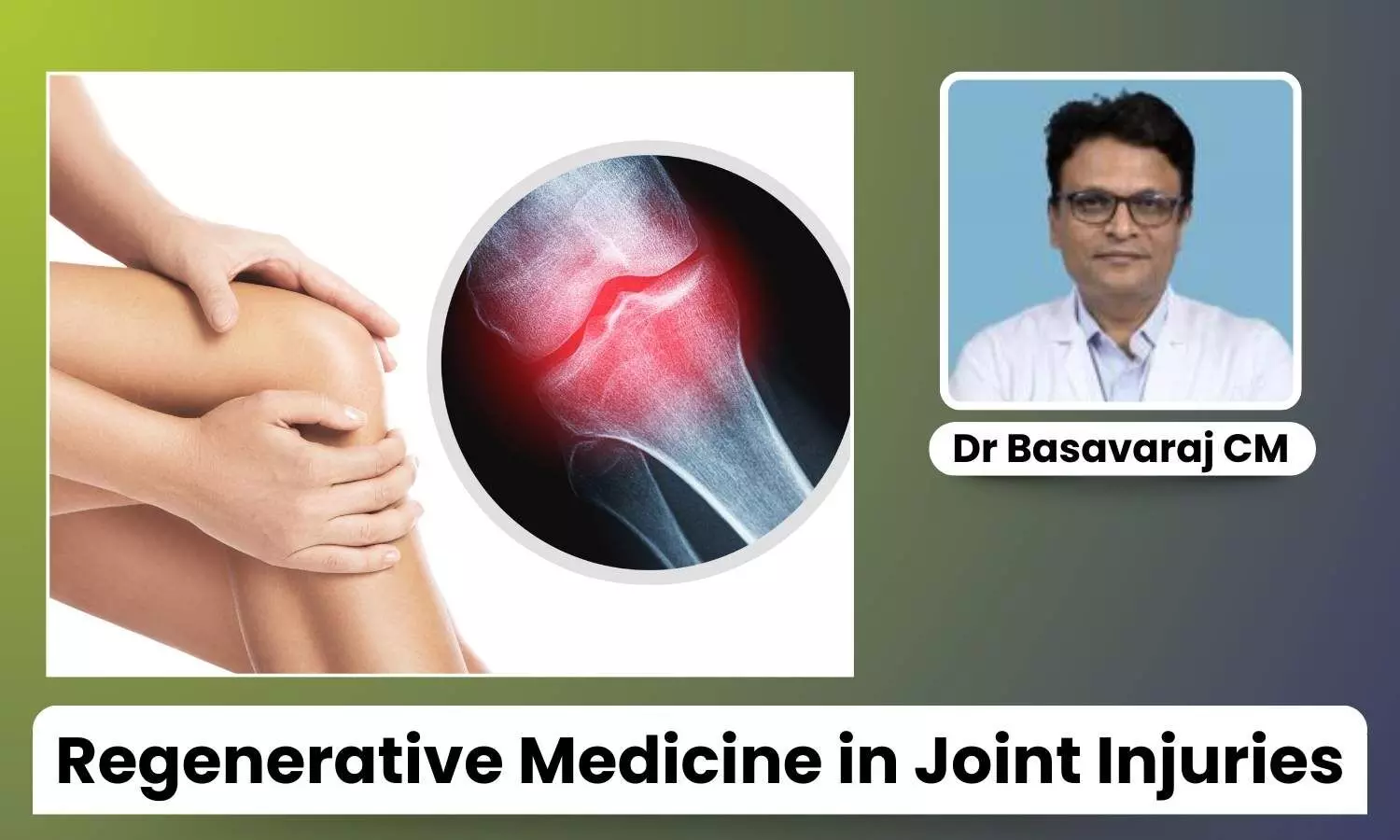Role of Regenerative Medicine in Treating Joint Injuries: Can Stem Cells Help Heal Damaged Tissue? - Dr Basavaraj CM

Joint injuries are a common health concern affecting millions worldwide, often resulting from sports activities, ageing, or degenerative conditions like osteoarthritis.
While conventional treatments such as pain medications, physical therapy, and surgical interventions provide relief, they often fall short of restoring full joint function or halting disease progression.
This limitation has sparked growing interest in regenerative medicine, particularly stem cell therapy, as a promising avenue for treating joint injuries and promoting tissue healing.
What is Regenerative Medicine?
Regenerative medicine is an advanced field of medical science focused on harnessing the body’s natural ability to repair, regenerate, and replace damaged tissues.
It involves innovative approaches using biological materials such as stem cells, platelet-rich plasma (PRP), and growth factors to stimulate tissue repair and functional restoration.
Among these, stem cell therapy has gained significant attention for its potential in treating joint injuries due to its ability to promote healing at the cellular level.
Understanding Stem Cells
Stem cells are unique cells in the body capable of transforming into various cell types, including cartilage, bone, and muscle cells. They can also release bioactive substances that help reduce inflammation and stimulate tissue repair.
There are two main types of stem cells used in joint injury treatments:
- Mesenchymal Stem Cells (MSCs) – Commonly derived from bone marrow, adipose (fat) tissue, or umbilical cord tissue. These cells are known for their regenerative and anti-inflammatory properties.
- Hematopoietic Stem Cells (HSCs) – Primarily found in bone marrow and involved in blood cell production, though less commonly used for joint repairs.
How can Stem Cells Help in Joint Injuries?
When introduced into a damaged joint, stem cells can:
- Promote Cartilage Repair: Stem cells can differentiate into chondrocytes, the primary cells in cartilage, which help restore damaged cartilage tissue.
- Reduce Inflammation: Stem cells release cytokines and growth factors that reduce inflammation, helping with pain relief and slowing disease progression.
- Enhance Tissue Healing: Growth factors secreted by stem cells stimulate surrounding tissues to repair themselves, accelerating the healing process.
Conditions Where Stem Cell Therapy Shows Promise
Stem cell treatments have shown promising results for various joint-related conditions, including:
- Osteoarthritis: Stem cells help slow cartilage degeneration and may promote new cartilage formation in the early stages of arthritis.
- Ligament and Tendon Injuries: Particularly effective for partial tears in ligaments like the ACL or rotator cuff injuries.
- Meniscus Tears: Stem cells can aid in the healing of mild to moderate meniscal injuries in the knee.
The Procedure: What to Expect
Stem cell therapy for joint injuries is typically a minimally invasive outpatient procedure:
- Stem Cell Extraction: Cells are harvested from the patient’s bone marrow (usually from the pelvis) or fat tissue.
- Processing: The stem cells are concentrated and prepared for injection.
- Injection: The prepared stem cells are injected directly into the affected joint under ultrasound or fluoroscopic guidance.
Recovery is generally quick, with minimal downtime compared to surgical interventions.
Current Evidence and Limitations
While early clinical studies have shown positive results, it is important to note that stem cell therapy is still considered an emerging treatment. Key points to consider:
- Positive Outcomes: Many patients report reduced pain and improved joint mobility, particularly for mild to moderate arthritis and soft tissue injuries.
- Limitations: Stem cell therapy may not fully restore severely damaged cartilage in advanced arthritis cases.
- Ongoing Research: More large-scale, long-term clinical trials are needed to establish standardized protocols and long-term efficacy.
Safety and Risks
Stem cell therapy is generally considered safe when performed by qualified professionals. Since the cells are often autologous (sourced from the patient’s body), the risk of rejection is minimal. However, there are potential risks like:
- Infection (rare with proper sterile techniques)
- Temporary swelling or discomfort at the injection site
- Unregulated clinics offering unproven treatments
Future of Stem Cell Therapy in Joint Care
The future of regenerative medicine looks promising, with ongoing research focusing on combination therapies like PRP with stem cells and gene therapy. These advancements aim to maximize the healing potential of stem cells and expand treatment options for joint injuries.
Conclusion
Stem cell therapy represents a groundbreaking approach in regenerative medicine for treating joint injuries and managing conditions like osteoarthritis.
While not yet a universal cure, it offers hope for patients seeking alternatives to surgery with the potential for pain relief, improved mobility, and enhanced healing.
As research continues to evolve, stem cell therapy could play a pivotal role in revolutionizing joint care in the years to come.
Disclaimer: The views expressed in this article are of the author and not of Health Dialogues. The Editorial/Content team of Health Dialogues has not contributed to the writing/editing/packaging of this article.


